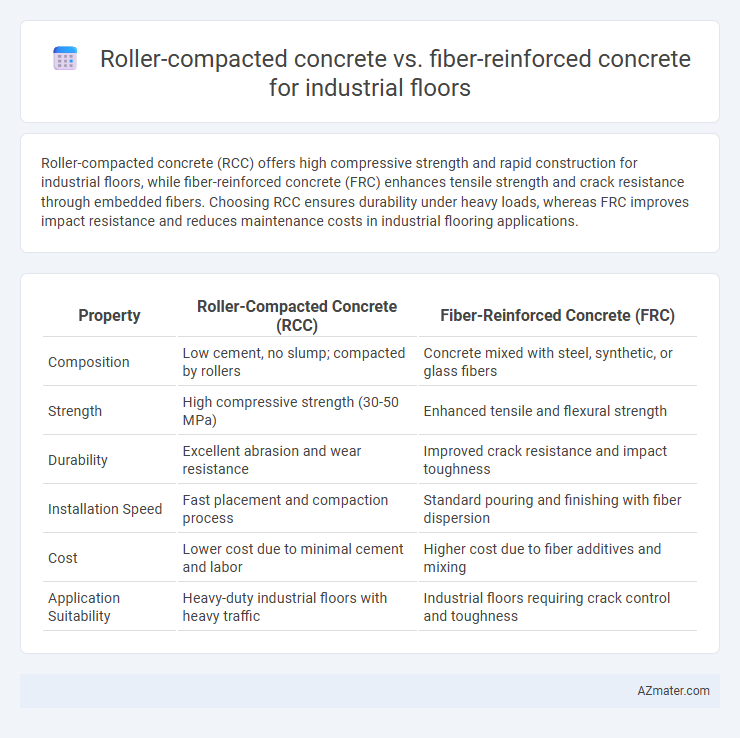Roller-compacted concrete (RCC) offers high compressive strength and rapid construction for industrial floors, while fiber-reinforced concrete (FRC) enhances tensile strength and crack resistance through embedded fibers. Choosing RCC ensures durability under heavy loads, whereas FRC improves impact resistance and reduces maintenance costs in industrial flooring applications.
Table of Comparison
| Property | Roller-Compacted Concrete (RCC) | Fiber-Reinforced Concrete (FRC) |
|---|---|---|
| Composition | Low cement, no slump; compacted by rollers | Concrete mixed with steel, synthetic, or glass fibers |
| Strength | High compressive strength (30-50 MPa) | Enhanced tensile and flexural strength |
| Durability | Excellent abrasion and wear resistance | Improved crack resistance and impact toughness |
| Installation Speed | Fast placement and compaction process | Standard pouring and finishing with fiber dispersion |
| Cost | Lower cost due to minimal cement and labor | Higher cost due to fiber additives and mixing |
| Application Suitability | Heavy-duty industrial floors with heavy traffic | Industrial floors requiring crack control and toughness |
Introduction to Industrial Flooring Solutions
Industrial flooring solutions prioritize durability and strength to withstand heavy machinery and high traffic. Roller-compacted concrete (RCC) offers rapid installation and exceptional compressive strength, making it ideal for large industrial spaces requiring cost-effective, high-load-bearing surfaces. Fiber-reinforced concrete (FRC) enhances tensile strength and crack resistance, providing improved durability and longevity in environments subjected to dynamic and impact stresses.
Overview of Roller-Compacted Concrete (RCC)
Roller-compacted concrete (RCC) is a dry, zero-slump concrete mixture compacted with vibratory rollers, ideal for industrial floors requiring high strength and durability. Its rapid placement and lower water content result in a dense, abrasion-resistant surface capable of withstanding heavy traffic and loads. RCC offers cost-effective construction with minimal curing time, making it suitable for large-scale industrial flooring projects.
Overview of Fiber-Reinforced Concrete (FRC)
Fiber-reinforced concrete (FRC) enhances industrial floor durability by incorporating synthetic, steel, or glass fibers, improving tensile strength, crack resistance, and impact absorption. Compared to roller-compacted concrete (RCC), FRC offers superior flexibility under dynamic loads and better resistance to shrinkage and temperature fluctuations. This makes FRC especially effective in industrial environments subjected to heavy machinery and frequent stress.
Key Material Properties Comparison
Roller-compacted concrete (RCC) offers exceptional compressive strength and rapid installation, making it ideal for heavy industrial floor applications requiring high load-bearing capacity and durability. Fiber-reinforced concrete (FRC) enhances flexural strength and crack resistance through the integration of synthetic or steel fibers, improving impact toughness and reducing maintenance costs in industrial environments. Both materials provide superior abrasion resistance and durability, but RCC excels in compressive performance while FRC delivers improved tensile strength and ductility for industrial flooring.
Installation Process: RCC vs FRC
Roller-compacted concrete (RCC) installation involves spreading and compacting a zero-slump concrete mix with heavy rollers, making it faster and more cost-effective for large industrial floor areas. Fiber-reinforced concrete (FRC) requires traditional placing and finishing methods, including vibration to ensure uniform fiber distribution and prevent segregation, which can increase labor time and complexity. RCC's mechanical compaction reduces curing time, while FRC demands careful attention during finishing to maximize fiber performance and durability.
Performance and Durability in Industrial Settings
Roller-compacted concrete (RCC) excels in industrial flooring due to its high compressive strength and rapid construction, enabling heavy load-bearing and resistance to abrasion from forklifts and machinery. Fiber-reinforced concrete (FRC) enhances durability by improving tensile strength, crack resistance, and impact absorption, reducing maintenance in harsh operational environments. Both RCC and FRC offer superior performance, with RCC favored for large-scale, fast-paced projects and FRC preferred where enhanced toughness and longevity against dynamic stresses are critical.
Load-Bearing Capacity Differences
Roller-compacted concrete (RCC) provides superior load-bearing capacity for industrial floors due to its high density and low porosity, enabling it to withstand heavy traffic and dynamic loads effectively. Fiber-reinforced concrete (FRC) enhances tensile strength and crack resistance by incorporating synthetic or steel fibers, improving durability under repetitive stress but generally offering lower compressive strength compared to RCC. Choosing between RCC and FRC depends on specific load requirements, with RCC favored for extremely heavy loads and FRC providing better performance against surface wear and flexural stresses.
Cost Analysis: Initial and Long-Term
Roller-compacted concrete (RCC) offers lower initial costs due to faster laying and reduced labor, making it ideal for large industrial floors requiring quick installation. Fiber-reinforced concrete (FRC) has higher upfront expenses attributed to fiber materials and mixing complexity but reduces long-term maintenance by improving crack resistance and durability, leading to lower repair costs over time. Analyzing lifecycle costs, FRC provides economic benefits in environments with heavy loads and frequent stress, while RCC suits budget-sensitive projects with moderate durability demands.
Maintenance and Lifespan Considerations
Roller-compacted concrete (RCC) offers low maintenance due to its dense, durable structure that resists wear and requires minimal surface treatments, making it ideal for high-traffic industrial floors with extended lifespans up to 40 years. Fiber-reinforced concrete (FRC) enhances crack resistance and structural integrity, reducing maintenance costs associated with crack repairs and extending lifespan by improving durability in dynamic loading environments. Both RCC and FRC significantly outperform traditional concrete, but FRC's enhanced tensile strength and crack control provide superior long-term performance in industrial flooring subjected to heavy mechanical stresses.
Choosing the Right Concrete Solution for Your Industrial Floor
Selecting the right concrete solution for industrial floors requires evaluating Roller-compacted concrete (RCC) and Fiber-reinforced concrete (FRC) based on durability, strength, and maintenance needs. RCC offers rapid installation and high compressive strength, making it ideal for heavy-load areas with minimal surface finish requirements. FRC enhances tensile strength, crack resistance, and impact tolerance, providing superior performance in environments subject to dynamic loads and frequent heavy traffic.

Infographic: Roller-compacted concrete vs Fiber-reinforced concrete for Industrial floor
 azmater.com
azmater.com